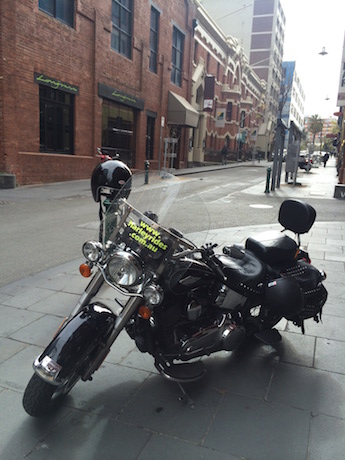Melbourne has just become the most progressive city in Australia and possibly the world for promoting motorcycle parking on footpaths and actively encouraging riders into the inner city, at the expense of cars.
Now it’s time for other cities around the world to pay attention to the Melbourne City Council 2015-2018 Motorcycle Plan which passed unanimously last night (May 5, 2015).
There were three last-minute amendments to the progressive plan, but even they were helpful to the cause.
One advocates converting 20 car spaces into free bike parking – amazing that a government is actively forgoing revenue estimated to be about $250,000 in the coming year – and the other two relate to a survey of the suitability of allowing motorcycle parking on footpaths less than 2m.
Yet when we approached Brisbane City Council to follow suit with Melbourne’s progressive footpath parking which has been in place for about two decades, they replied that Brisbane’s footpaths were too narrow. What utter rubbish! Most Brisbane footpaths are much wider than 2m.
Independent Riders Group spokesman Damien Codognotto is jubilant about the plan.
“You never get every thing you want but this came pretty close,” he says. “Where motorcycles and scooters are concerned, Melbourne is way ahead of other other Australian cities. Sydney and Brisbane really need footpath bike parking.”
 The progressive plan also advocates the following:
The progressive plan also advocates the following:
- Plastic barriers around dangerous construction sites and protection around median strip trees;
- Replacing steel and concrete bollards with plastic flexible ones;
- Investigate solutions for slippery road paint, tram lines and metal plates;
- Encourage the State Government to accept lane filtering (this is being introduced in September, but the specific rules have not et been released) and allow riders to use bus lanes;
- Identify more places for free footpath parking and make it easier to find with appropriate signs;
- Investigate early start-up for riders at traffic lights; and
- Consider allowing riders access to closed roads and entry/turn bans.
Melbourne has long been a conducive environment for riding motorcycles with free footpath parking and, until last year, no tolls. Consequently, the city has witnessed a steady growth of motorcycles from 1.5% of traffic in 2006 to 2.6% in 2014. That’s 73% in eight years, despite the fact that the changeable weather can often work against the rider!
As an urban environment, Melbourne isn’t too different from most other cities around the world, so why don’t more cities recognise the benefits of motorcycles and actively encourage them by creating a nurturing and rewarding climate?



 The progressive plan also advocates the following:
The progressive plan also advocates the following: